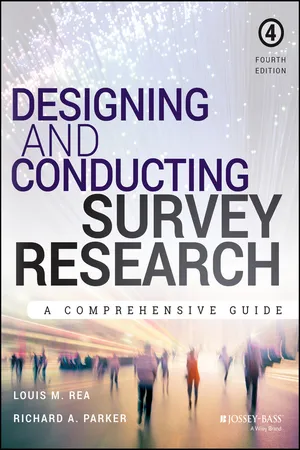
Designing and Conducting Survey Research
A Comprehensive Guide
- English
- ePUB (mobile friendly)
- Available on iOS & Android
About this book
The industry standard guide, updated with new ideas and SPSS analysis techniques
Designing and Conducting Survey Research: A Comprehensive Guide Fourth Edition is the industry standard resource that covers all major components of the survey process, updated to include new data analysis techniques and SPSS procedures with sample data sets online. The book offers practical, actionable guidance on constructing the instrument, administrating the process, and analyzing and reporting the results, providing extensive examples and worksheets that demonstrate the appropriate use of survey and data techniques. By clarifying complex statistical concepts and modern analysis methods, this guide enables readers to conduct a survey research project from initial focus concept to the final report.
Public and nonprofit managers with survey research responsibilities need to stay up-to-date on the latest methods, techniques, and best practices for optimal data collection, analysis, and reporting. Designing and Conducting Survey Research is a complete resource, answering the "what", "why", and "how" every step of the way, and providing the latest information about technological advancements in data analysis. The updated fourth edition contains step-by-step SPSS data entry and analysis procedures, as well as SPSS examples throughout the text, using real data sets from real-world studies. Other new information includes topics like:
- Nonresponse error/bias
- Ethical concerns and special populations
- Cell phone samples in telephone surveys
- Subsample screening and complex skip patterns
The fourth edition also contains new information on the growing importance of focus groups, and places a special emphasis on data quality including size and variability. Those who employ survey research methods will find that Designing and Conducting Survey Research contains all the information needed to better design, conduct, and analyze a more effective survey.
Frequently asked questions
- Essential is ideal for learners and professionals who enjoy exploring a wide range of subjects. Access the Essential Library with 800,000+ trusted titles and best-sellers across business, personal growth, and the humanities. Includes unlimited reading time and Standard Read Aloud voice.
- Complete: Perfect for advanced learners and researchers needing full, unrestricted access. Unlock 1.4M+ books across hundreds of subjects, including academic and specialized titles. The Complete Plan also includes advanced features like Premium Read Aloud and Research Assistant.
Please note we cannot support devices running on iOS 13 and Android 7 or earlier. Learn more about using the app.
Information
PART ONE
DEVELOPING AND ADMINISTERING QUESTIONNAIRES
CHAPTER ONE
AN OVERVIEW OF THE SAMPLE SURVEY PROCESS
Gathering Information through Research
- Secondary research: Certain data may already exist that can serve to satisfy the research requirements of a particular study. Any study should investigate existing sources of information as a first step in the research process to take advantage of information that has already been collected and may shed light on the study. Sources of secondary information include libraries, government agencies, and private foundations, among others.
- Direct measurement: This technique involves testing subjects or otherwise directly counting or measuring data. Testing cholesterol levels, monitoring airport noise levels, measuring the height of a building to make certain it complies with local ordinances, and counting ballots in a local election are all examples of direct measurement.
- Observation: A primary characteristic of observation is that it involves the direct study of behavior by simply watching the subjects of the study without intruding on them and recording certain critical natural responses to their environment. For example, a government official can obtain important information about the issues discussed in a speech by observing the audience's reactions to that speech.
- How do Americans feel about proposed changes in social security regulations?
- What is the average income of people twenty-five years of age and older whose highest level of completed education is high school?
- What factors influence people's choice of banks?
- What are the reactions among employees of a local factory concerning a newly proposed union policy?
- How do members of the New York State Bar Association feel about capital punishment?
- What do various state legislators think about a proposed mandatory balanced-budget amendment?
- What proportion of drivers observe seat belt laws?
- To what extent has the Latino community in Texas experienced job discrimination?
Table of contents
- Cover
- Series
- Title Page
- Copyright
- Preface
- The Authors
- Part One: Developing and Administering Questionnaires
- Part Two: Ensuring Scientific Accuracy
- Part Three: Presenting and Analyzing Survey Results
- Resource A: Table of Areas of a Standard Normal Distribution
- Resource B: Glossary
- Bibliography
- Index
- EULA